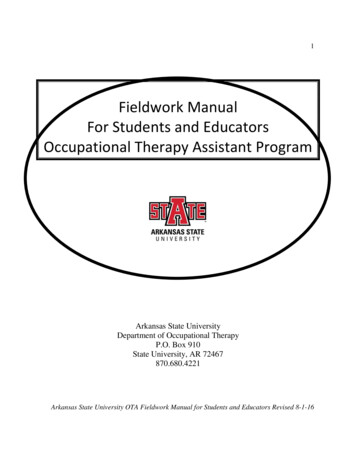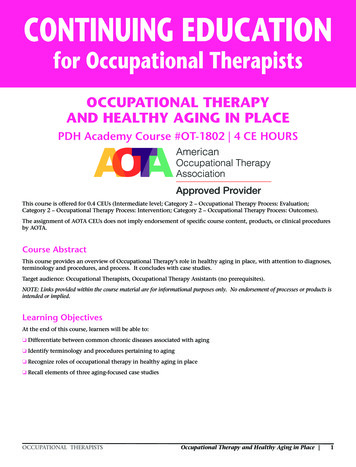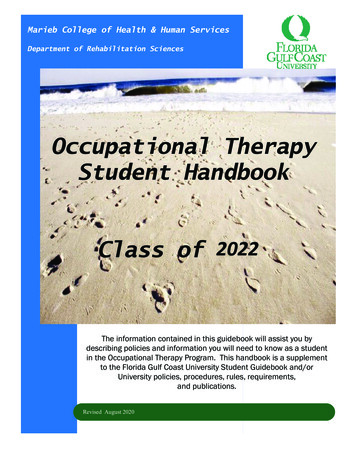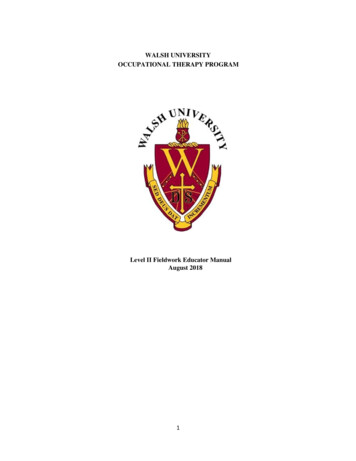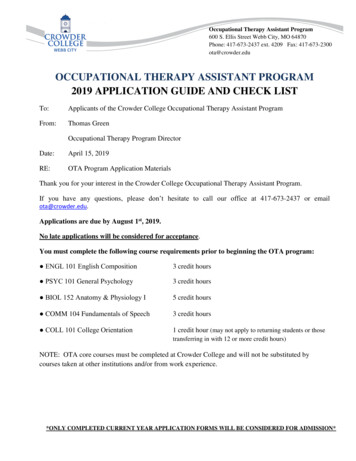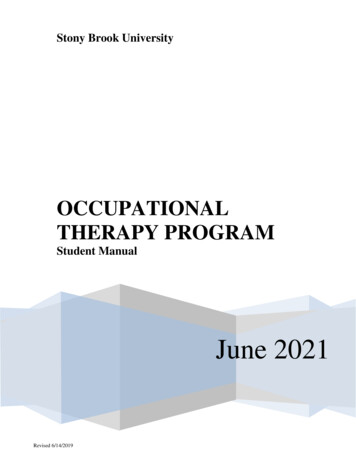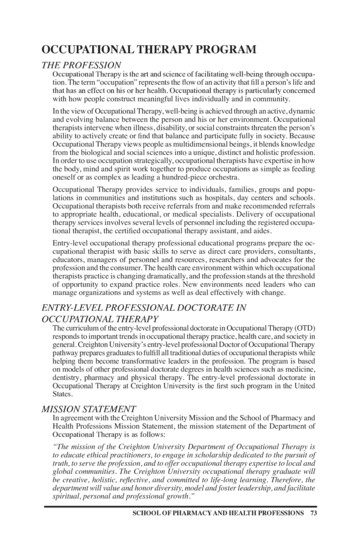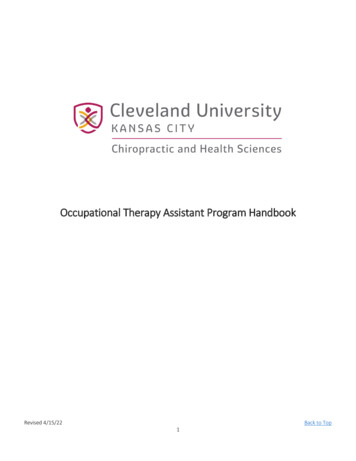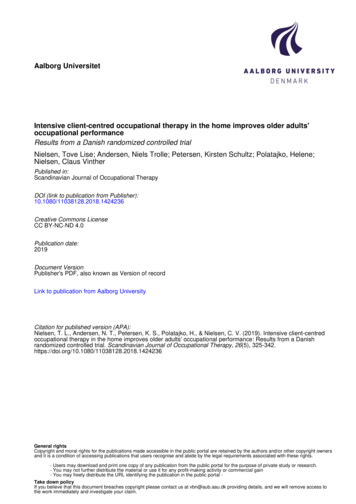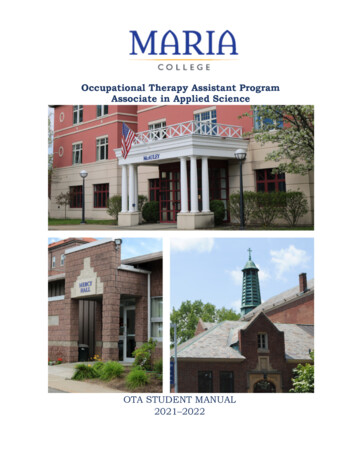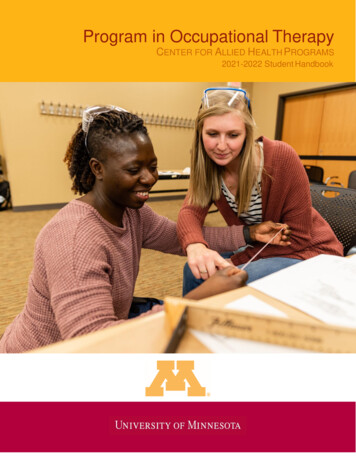
Transcription
Program in Occupational TherapyCENTER FOR ALLIED HEALTH PROGRAMS2021-2022 Student Handbook
The policies, procedures, and program requirements outlined in this handbook are in effect as ofFall 2020. Entering students are responsible for program requirements in effect at the time ofinitial enrollment. Policies and procedures are subject to change and are communicated to allOccupational Therapy students upon approval by the OT faculty.The University of Minnesota shall provide equal access to and opportunity in its programs,facilities, and employment without regard to race, color, creed, religion, national origin, gender,age, marital status, disability, public assistance status, veteran status, sexual orientation,gender identity, or gender expression.Inquiries regarding compliance may be directed to the Director, Office of Equal Opportunity andAffirmative Action, University of Minnesota, 274 McNamara Alumni Center, 200 Oak Street S.E.,Minneapolis, MN 55455, (612) 624-9547, eoaa@umn.edu, or https://diversity.umn.edu/eoaa/.This publication is available in alternative formats upon request. Please contact:Center for Allied Health Programs University of MinnesotaMMC 714, 516 Delaware St SERoom 15-194, PWBTel: (877) 334-2659 E-mail: cahpinfo@umn.edu Web: www.alliedhealth.umn.edu Regents of the University of Minnesota. All rights kbooktudHan2021-2022 OTD Student HandbookPagege 2 iPage 3
Program Mission, Philosophy, and Overview of the Profession . 6Our Mission . 6Our Curriculum. 7Our Philosophy . 9Overview of the Profession . 11Certification and Licensure . 12Curriculum . 13Course Plan and Course Descriptions . 15Fall (year 1, Semester 1). 15Accreditation . 22Graduation Information . 23Faculty . 24Faculty Emeritus or Ad Honoreum . 27Policies & Procedures . 29OT Program Policies . 29Faculty Advising Roles & Responsibilities . 29Academic Performance and Student Conduct . 31Academic Performance . 31Academic Performance. 31Professional Behavior . 32Academic Performance and Professional Behavior Issues . 32Complaint Process within the OT Program . 37Student Conduct . 39Social Media Policy. 42Association Membership & Subsidy . 43Communication . 44Conference Attendance . 45Course Notes . 47Cardiopulmonary Resuscitation (CPR) Certification . 48Ethics: OT Code of Ethics. 48Exam Accommodations. 49Grading Policy in OT Program . 49Instructional Policies . 50OT Lab/ Classroom Safety, Equipment, Emergency Planning . 50COVID-19 Safety Measures . 51Classroom Management . 51Safety and Emergency Planning . 52Schedules and Calendars . 52Inclement Weather Policy . 52Performance Site Transfer Guidelines . 53Program in Occupational Therapy Minimum Technical Standards . 532021-2022 OTD Student HandbookPage 4
General Policies. 57Contact Information & Emergency Contacts Changes. 57Criminal Background Studies . 57Health Insurance Coverage . 57Voluntary Student Dental Plan . 58Long-term Disability Insurance Coverage . 58Student Services Fee . 58Health Insurance Portability and Accountability Act (HIPAA). 59Bloodborne Pathogen Training . 59Immunization Policy and Requirements . 60Legitimate Absences . 60Reference Requests . 61Sexual Harassment and Discrimination . 61Health Sciences Social Media Policy . 62Student Record Access . 62Students Managing Their Educational Records . 62Student Responsibilities for Teaching and Learning . 62Tuition and Fees . 63Tuition Refunds due to Course Cancellation or Withdrawals . 64Resources . 65Student Conflict Resolution Center . 65University Counseling and Consulting Services . 65Disability Resource Center (DRC) . 65Effective U . 65Office of Equal Opportunity and Affirmative Action (EOAA) . 66Financial Wellness Counseling . 66Health Services – Twin Cities (Boynton Health Services) . 66Health Services – Rochester (Olmsted Medical Center) . 67Study Space Finder (Minneapolis & St. Paul Campuses) . 67Center for Allied Health Programs Overview . 68Mission . 68Administration . 68CAHP Student Services & CAHP Academic Advising . 69Program Support Staff . 69One Stop Student Services . 70Forms . 702021-2022 OTD Student HandbookPage 5
PROGRAM OVERVIEWProgram Mission, Philosophy, and Overview of the ProfessionOur MissionThe mission of the Program in Occupational Therapy (the Program) reflects the mission of the University ofMinnesota (the University) as a whole: to benefit the people of the state, nation and world through research anddiscovery, teaching and learning, and outreach and public service.Occupational Therapy at the University of Minnesota has as its mission to: educate leaders in occupational therapy through innovative experience-based education and research, advance the science of occupational therapy, and foster the health and quality of life of persons, communities (including families), and populations.We strive to accomplish our mission by creating a community of scholars, teachers and students devoted to creatingnew knowledge and applying current knowledge to everyday practice. We embrace the values of a land grantinstitution to serve the needs of Minnesota through inclusive practices, outreach to areas of need, and translation ofmost current knowledge to practice.The Program has teaching and learning at its core. The Program's primary purpose is the preparation of entry-levelprofessionals capable of the creative and independent critical thinking required for current and future practice andresearch in occupational therapy. In this way, the Program directly aligns with the institutional mission to prepareprofessionals for active roles in an increasingly diverse world.The Program also aligns with the institution’s research and discovery mission through the Program’s commitment tostudy and disseminate advances in occupational therapy practice, and in the science of teaching and learning.Professional occupational therapy students interact with research doctoral students and faculty who mentor bothprofessional and research doctoral students in the ongoing development of effective practice.Outreach and public service is offered through: broad community-based experiential learning opportunities supported by the Program, community-based research questions investigated by faculty and students, and activities in which the local community leads the determination of a project of value.The Program is committed to making a difference in academic and health services and programs within theUniversity, Minnesota, our nation, and beyond through its graduates, research, community interactions and faculty.The Program will be recognized for its innovative approaches to education and practice, known as experts in the useof technology-enhanced learning, and considered as leaders in the use and effects of occupation on health, wellbeing, and quality of life.Approved by occupational therapy faculty November 19, 2018. Supersedes Mission Statement adopted 2007.2021-2022 OTD Student HandbookPage 6
Our CurriculumTHEMESFive themes organize the curriculum. They align with the program’s mission and philosophy, drive the programlearning goals, and structure the sequence of course delivery. These themes are represented in the schema belowand are listed here: Occupations change across the lifespan and are essential to health and wellness. Learners firstgrapple with concepts of occupation and core beliefs of occupational therapy. Semesters 2-5 focuson the development of occupation across a series of three developmentally based courses:child/youth, adults, and older adult. Learning is best through experience. Each didactic course is designed based upon the doing ofoccupational therapy in increasingly realistic cases. Students complete four faculty-driven Level Ifieldwork courses in child/youth, adult, older adult alongside, but separate from corresponding didacticcourses. Building and using evidence is core to practice. Courses build upon a sequence that begins withevaluating evidence to understanding research and ending with individual data-based projects that area part of the Capstone experience. Clients are individuals, communities and populations. Clients are consistently described broadly,particularly in the development courses sequences of child/youth, adults, and older adults. Each courseaddresses assessment and intervention of persons, groups, and populations. Occupational therapists are innovative leaders.The hands at the bottom of the schemarepresent how occupations change acrossthe lifespan and how building and usingevidence are foundational constructs.Concentric circles in the middle representclients are individuals, communities, andpopulations. Persons are surrounded bycommunities and populations whichtogether foster participation in everydaylife.Each quadrant represents knowledgethemes of occupational practice:graduates are innovative leaders with afocus in an area of advanced practice.The horizontal bar represents theimportance of learning throughexperience- a reminder that experientiallearning is the focus of our teaching.2021-2022 OTD Student HandbookPage 7
Student Learning GoalsOccupational therapy graduates will1. Evaluate models, policies and systems in settings where occupational therapy services are emerging ordelivered (Themes 1, 4 & 5). Appraise current and future directions for health care education, and social service systems thatguide practice and service (Themes 4 & 5). Critique health, education, employment, academic and community models that structureemerging OT services (Theme 5). Create innovative practice in emerging OT settings (Theme 5). Analyze policies and develop, formulate procedures for effective OT services (Theme 5)2. Evaluate evidence to drive innovative practice for populations, communities, and individuals (Themes 3 &4). Identify a problem for a population-, community-, or individual-level practice related problem orquestion (Themes 3 & 4). Appraise evidence relevant to the question or problem and reframe their questions accordingly(Theme 4). Formulate a research proposal around their practice-related problem or question (Theme 4).3. Achieve proficiency in one of the following areas of advanced practice: clinical practice, research,administration, leadership, program and policy development, advocacy, education, or theory development. Compare and contrast 3-4 potential specialty practice areas (Themes 3 & 5). Apply, analyze, and evaluate the interaction of occupation and activity, including areas ofoccupation, performance skills, performance patterns, contexts(s) and environments, and clientfactors (Themes 1 & 3). Investigate knowledge, skills and attitudes needed to possess emerging expertise in specialtyarea (Themes 2, 3, & 4). Develop capstone project in selected specialty area (Theme 2). Formulate specific individualized capstone objectives and plan (Themes 2 & 5). Develop the knowledge, skills, and attitudes needed to possess expertise in specialty [advanced]practice area (Themes 2 & 5). Demonstrate emerging expertise through the application of knowledge, skills, and attitudes inspecialty area (Themes 2 & 5).4. Inspire, empower and lead others to be agents of beneficial change (Theme 5). Understand leadership practices and how they impact behavior of individuals and groups inorganizations, examples across multiple contexts (Theme 5). Analyze leadership examples across multiple contexts (Theme 5). Confidently facilitate development of a shared vision (Theme 5). Professionally challenge the status quo (e.g. ask critical questions, take risks in groups, learnfrom mistakes) (Theme 5). Create an atmosphere of trust and dignity (Theme 5).1American Occupational Therapy Association. (2014). Occupational therapy practice framework: Domain andprocess (3rd ed.). American Journal of Occupational Therapy, 68(Suppl. 1). 021-2022 OTD Student HandbookPage 8
Our PhilosophyThe Program in Occupational Therapy (the Program) faculty developed its statement of philosophy bystudying, contemplating, and discussing the truths that are held in common about humanity, health,occupation, and occupational therapy. These beliefs drive our view of the profession and our teaching. Thestatement reflects consensus of the faculty, is consistent with the University, reflects the current publishedphilosophy of the profession, and serves as the basis for the Program’s curricular design andimplementation.The Program is grounded on the certitude that all Human Beings: Have inherent worth and must be treated with dignity and respect. Have an incontrovertible need and right to engage in meaningful occupations across their lifespans.One important way that humans create meaning is by engaging in occupations, the activities ofeveryday life, named, organized, and given value and meaning by persons, communities (includingfamilies), and populations. These occupations are unique responses to the dynamic interactionsthat form patterns of meaningful participation in life. Are affected by context.These contexts may be social, physical, cultural, personal, temporal, and virtual, including thepolitical and economic environments influencing individuals and groups. Contexts may enhance,impair, or totally block participation and engagement in occupation. Have an expansive capacity to change.Change may be self-created, e.g., generated spontaneously from within, or in response tooccupational needs or contextual challenges. When change is responsive to an internal or externaldemand or pressure, the term adaptation is commonly applied. Change may be adaptive i.e.,moving toward health, or maladaptive i.e., moving away from health. Occupational therapyfacilitates adaptation, and relies on the dynamism of humans as being capable of change.The Program considers Health to be a construct that reflects both personal and social interpretations andcan be confidently extended to persons, communities and populations. The Program ascribes to the World Health Organization’s definition of health as a person or group’sstate of complete physical, mental, and social sense of well-being. Health does not require absenceof disease or disability, nor does it require congruence between personal and societal or populationviews. A person or group may consider themselves healthy in spite of chronic health problems andin spite of a larger society or population considering the same person or group as ill.2021-2022 OTD Student HandbookPage 9
Health is created through the unique dynamic interplay between the person or group and their environmentsand occupations. Persons and groups develop health when they engage in occupations that are meaningfulto the person or group. Health may best be expressed as well-being or overall life satisfaction when persons and groups participate inmeaningful occupations.Occupational therapists facilitate health, wellness, and wellbeing through therapeutic use of personal and groupoccupations and activities, including necessary preparatory methods and tasks, education and training, andadvocacy.Occupational TherapyThe Program believes in the therapeutic value of occupation for persons and groups who are experiencing, or areat risk of experiencing, limited participation in everyday life. It further holds that engagement in occupation isessential to health maintenance, promotion and wellness; restoration or compensation for impairment; preventionof disease or injury; and adaptation as a part of development and continued living.Occupational therapy is an evidence-based profession dedicated to promoting health, well-being, and quality of lifein persons, communities, and populations. While many health professions share these goals, occupational therapy isunique in its focus on occupation, i.e., meaningful doing, as both the means and the outcome of intervention.Occupational therapy encourages fullest participation by changing the person’s or groups’, contexts, and ways ofdoing meaningful occupations.Student LearningThe Program believes that students are active participants in their own learning and this best occurs when facultydesign role-relevant, purposeful learning opportunities coupled with inherent performance feedback. We believethat students learn best when faculty design learning activities based on the following principles.1. Hybrid education is the systematic blending of online and on-ground learning activities. On-groundlearning occurs in settings where students are physically present for the learning activity, e.g., laboratory,experiential environment, and face to face classroom discussions. Each online and on-ground activity isdesigned to achieve clearly specified learning outcomes. Thus, hybrid teaching and learning facilitatesopportunities for students to actively engage in their learning and provides the strongest professionaleducation. Online or on-ground learning activities are selected by faculty to best achieve desired learningoutcomes. Faculty engineer these learning activities using web-based technology balanced with activeface-to-face experiential activities to develop the occupations or skills of practice.2. Experiential learning. The Program’s experiential learning model is predicated on the belief thatincreasingly real world contexts best facilitate student learning. Learners practice increasingly complex skillsin settings ranging from low-realism situations in classrooms and laboratories to high verisimilitude ‘reallife’ simulations of practice settings, to real-life contexts. Faculty members adapt the complexity of theskill to be learned and/or alter the setting’s congruence to real world practice to promote adaptivelearning.3. Reflective learning. By critically reflecting and being anchored in their own life experience, students changetheir patterns of thinking, feeling, believing, and in doing so, therapeutically link themselves to their2021-2022 OTD Student HandbookPage 10
therapeutic work. By critically reflecting on self and own-group and sharing these reflections with theirpeers and others, students build the skills to question assumptions and to examine alternative ways ofbeing and doing. This ‘thinking about your own thinking’ draws from metacognitive learning strategies thatguide how students assess their own understanding or performance.4. Self-determined learning occurs as students select learning options and apply new concepts to relevantcontexts at home, in the classroom, and in practice settings. Students increase flexibility when adapting toenvironmental changes while molding responses through practice. Faculty members design learningexperiences that focus on ‘how to learn’ rather than exclusively delivering content about “what to do”.5. Social learning is the final critical component of the Program’s hybrid learning curriculum, countering theindividualized learning that often can dominate a solitary online format. Students learn together and fromfaculty via their on-ground experiences through observation, imitation and modeling and by interactionswith occupational therapy and inter-professional faculty with known expertise and knowledge of practice.The Program offers opportunities for students to practice in the presence of experts, receive correctivefeedback in real time, and discuss how to change, grow, and master professionalism.Occupational Therapy Education has as its goal to prepare learners to: be practitioners competent in all the foundational skills of practice, read critically, understand and apply relevant current research to provide a basis forevidence based practice, exercise critical thinking and clinical reasoning skills, and embody the professional identity of serving the occupational needs of theircommunities.Overview of the ProfessionThe Program in Occupational Therapy prepares students to use occupations or everyday life activities withindividuals, groups and populations across the lifespan to enhance participation in their roles, habits, routines,and rituals in a variety of settings where they live, work, and play1. Occupational therapists serve as vitalmembers of a treatment team, consulting with physicians, physical and speech therapists, nurses, socialworkers, psychologists, vocational counselors, teachers, biomedical engineers, other specialists, and familymembers. They blend a scientific knowledge of the person with an understanding of the challenges of disability,environment and culture.The occupational therapy process includes evaluation of what a client wants to do compared to what they cando and then identifying those supports needed to facilitate maximum participation and engagement in theseoc
Occupational Therapy at the University of Minnesota has as its mission to: educate leaders in occupational therapy through innovative experience-based education and research, advance the science of occupational therapy, and foster the health and quality of life of persons, communities (including families), and populations.
